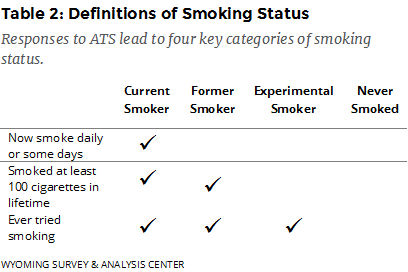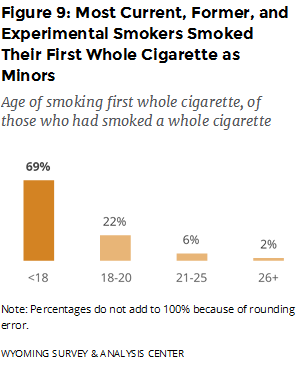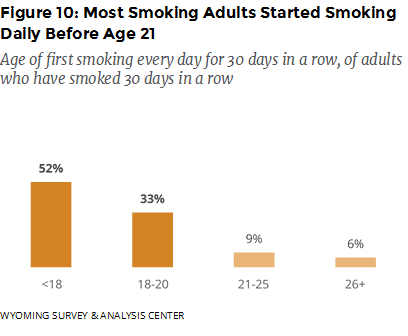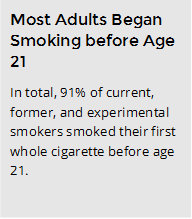 Goal Area 1: Preventing Initiation of Tobacco Use
Goal Area 1: Preventing Initiation of Tobacco Use
The Wyoming TPCP and the CDC share the goal of reducing the health burdens of tobacco use by preventing the initiation of tobacco use. A relatively recent effort in some local and state tobacco prevention programs outside of Wyoming has been to raise the legal age of purchase from 18 (or 19 in some jurisdictions) to 21 (see https://tobacco21.org/). We deviated from previous analytical approaches to provide data relevant to this emerging issue in tobacco prevention.

Age of Smoking a Whole Cigarette for the First Time
The majority (69%) of adults who have ever smoked a whole cigarette smoked their first whole cigarette when they were younger than 18 (Figure 9). However, there was still a large group (22%) who smoked a whole cigarette for the first time between the ages of 18 and 20. In total, 91% of current, former, and experimental smokers (see Table 2 for a summary of the four smoking status categories) smoked their first whole cigarette before age 21; this pattern has not changed significantly since comparable questions were first asked in 2010. In 2017, the average age at which adults who have ever smoked a whole cigarette smoked their first whole cigarette was 16 (with the median of 16 and the responses ranging from 4 to 58).
Age of Initiating Daily Smoking
 Among adults who had ever smoked at least one cigarette per day for at least 30 consecutive days (including current and former smokers), 85% said they started smoking daily when younger than 21 (Figure 10). This pattern has been stable since comparable questions were first asked in 2010.
Among adults who had ever smoked at least one cigarette per day for at least 30 consecutive days (including current and former smokers), 85% said they started smoking daily when younger than 21 (Figure 10). This pattern has been stable since comparable questions were first asked in 2010.
Role of ENDS in Initiation of Cigarette Smoking
The 2017 ATS asked current, former, and experimental smokers (see Table 2 for a summary of the four smoking status categories) who had also tried ENDS whether they had used cigarettes or ENDS first. For most of these smokers (72%), this question was not applicable because ENDS were not on the market (to their knowledge) when they started smoking. For those smokers who thought ENDS were on the market, 54% used ENDS first and 45% tried cigarettes first. These proportions are not significantly different.
Conclusions
 The smoking habits of the vast majority of smoking adults begin when they are under the age of 21, especially under the age of 18. Relatively few adults begin to smoke or begin to smoke daily after age 21. Although we cannot make causal inferences from these correlational data, the 2017 ATS provides some evidence in support of ENDS use as a potential gateway to smoking: 54% of current, former, and experimental smokers (see Table 2 for a summary of the four smoking status categories) who thought ENDS were available when they started smoking used ENDS before smoking a cigarette.
The smoking habits of the vast majority of smoking adults begin when they are under the age of 21, especially under the age of 18. Relatively few adults begin to smoke or begin to smoke daily after age 21. Although we cannot make causal inferences from these correlational data, the 2017 ATS provides some evidence in support of ENDS use as a potential gateway to smoking: 54% of current, former, and experimental smokers (see Table 2 for a summary of the four smoking status categories) who thought ENDS were available when they started smoking used ENDS before smoking a cigarette.

